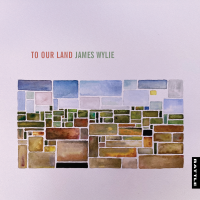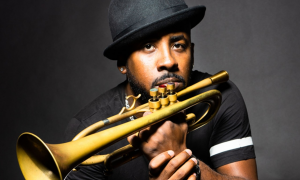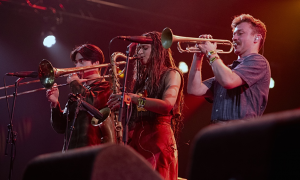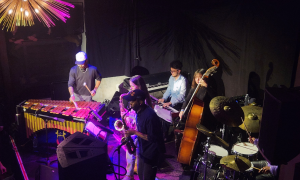Home » Jazz Articles » Live Review » Building Back Jazz Brick by Brick in East London
Building Back Jazz Brick by Brick in East London
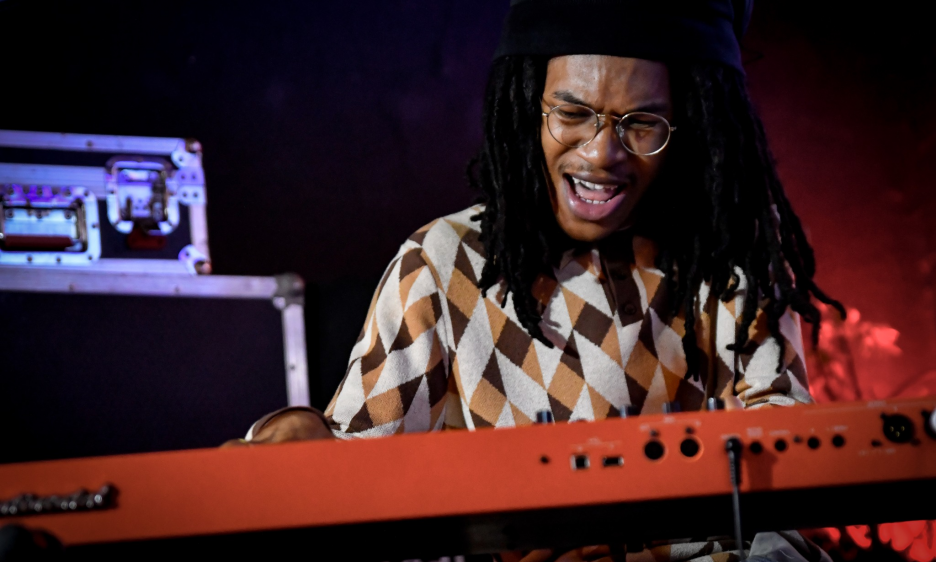
London
April 26-28, 2024
The most innovative and thrilling jazz currently emerging from the UK is centred on a few grimy, narrow streets on the east side of London. The pioneering work that goes on in this elaborately-graffitied neighbourhood has, in recent years, contributed much to the creation of an identifiably "London" jazz sound, and the Brick Lane Jazz Festival was the place to hear it in all its glory.
The area is a hive of activity, dominated by the dozens of long-established Bangladeshi restaurants that line Brick Lane itself, but it is ethnically as diverse as anywhere in London. With its many rich musical traditions, this wide variety of immigrant cultures has blended to create the aforementioned jazz stew—and it is not for purists: latin, hip-hop, soul, reggae, and electronica are all essential ingredients.
2024 marked the event's third successful year, if by successful we mean that the venues were packed and the music was of a uniformly high standard. It all happened across ten venues on or near the sprawling site of the Truman Brewery, once the world's largest, and one of its oldest—beer has been brewed here since 1666. The present owners have not only preserved the motley collection of post-industrial buildings, but given them a boho reboot, so that they are now home to numerous independent traders, artists, markets, boutiques, restaurants, cafes and bars.
Two other organisations are also key to the festival, and to the cultural renaissance it showcases: jazz re:freshed, who have spent 20 years providing musical career opportunities to young, female, and Black British jazz talent; and Tomorrow's Warriors who, with a similar and even longer self-imposed mission, have nurtured the careers of Moses Boyd, Nubya Garcia, Cassie Kinoshi and Nerija, Femi Koleoso and Ezra Collective, Binker Golding, Shabaka Hutchings and Sons of Kemet, Cherise, Eska, Denys Baptiste, Soweto Kinch, Zara McFarlane, and many others.
For greybeards like your correspondent, the youth and diversity of the Brick Lane audience is a striking feature of this festival. Young Londoners are attracted by the music, certainly, but also by the freshness of the faces on stage. Take the band Kikimiki, for example, who appeared at the Brick Lane Tap Room—really just a tiny pub—led by flautist and vocalist Keira Chakraborty. Their tunes, most featuring harmonized female voices, are bright, melodic and sunny, and largely self-penned. One started out feeling indulgent and supportive and went away afterwards seriously impressed by the virtuosity on display, notably from bassist Herbie Rees and drummer Miranda Radford, both aged 18.
Eight-piece Secret Night Gang were down from Manchester, where their particular brand of soul-jazz was born. Coming on like a cross between Tower of Power and Simply Red, they were greeted like conquering heroes by a capacity audience at the Juju Bar. While perhaps the songwriting would benefit from stronger melodies, the band's energy, skill and showmanship is undeniable, with the jazzy chops of trumpeter Aaron Wood particularly notable.
Myele Manzanza, a 36-year-old drummer with a Congolese father and New Zealand mother, has quickly risen to become one of the leading lights of contemporary jazz in London, regularly hosting late-night shows at Ronnie Scott's. In the context of the Brick Lane festival, he seemed like an elder statesman, with a powerful show at the Rich Mix cultural center. The star of this show was Grace Jones-esque vocalist, Zimbabwe-born, English-raised Zola Marcelle, whose lungs proved more than equal to the thunderous backing of Manzanza's trio.
Leading his own trio was another star of the festival, multi-instrumentalist David Mrakpor, who is rapidly establishing himself as more than just one half of Grammy Award-winning duo Blue Lab Beats. He will often start playing and carry on without a break until the end of the gig, seamlessly blending one tune into the next. Such is the transcendent beauty of his piano playing that the capacity audience at Rough Trade East, packed together like sardines, listened with rapt attention each time Mrakpor played a solo passage. You could have heard a pin drop.
The same pin clanged to the floor at 91 Living Room, where French-born bassist, vocalist and composer Amy Gadiaga took the stage with her trio—Luke Bacchus on piano and Simon Lamb on drums. Paris-born Gadiaga is evolving into one of the most interesting jazz musicians in the capital, and the audience was mesmerized into silence by her quiet authority and melodic gift. With its fluttery vibrato, her voice has something of Nina Simone about it, and her songwriting is nothing short of exquisite: the live set consisted mainly of songs from her new EP All Black Everything (jazz:refreshed, 2024).
One of the many joys of Brick Lane is the way in which musicians hop in and out of each other's bands. Earlier that same day, Bacchus hosted his own gig at Juju—a piano trio with the addition of steelpan player Marlon Hibbert. A recent finalist in the BBC's Young Jazz Musician of the Year, Bacchus has already developed a mature style steeped in his Guyanese heritage, as well as sly humor—his bassist, none other than Amy Gadiaga, purred her way through a slow tango-like version of "Caravan" so smoky and sinuous, she made Melody Gardot sound like Julie Andrews.
Tags
Live Review
Luke Bacchus
Peter Jones
United Kingdom
London
Brick Lane Jazz Festival
Jazz Re:freshed
Tomorrow's Warriors
Moses Boyd
Nubya Garcia
Cassie Kinoshi
Nerija
Femi Koleoso
Ezra Collective
Binker Golding
shabaka hutchings
Sons of Kemet
Cherise
Eska
Denys Baptiste
Soweto Kinch
Zara McFarlane
Kikimiki
Keira Chakraborty
Herbie Rees
Miranda Radford
SECRET NIGHT GANG
Tower of Power
Simply Red
Aaron Wood
Myele Manzanza
Ronnie Scott's
Zola Marcelle
David Mrakpor
Blue Lab Beats
Amy Gadiaga
Simon Lamb
Nina Simone
Marlon Hibbert
Melody Gardot
Julie Andrews
PREVIOUS / NEXT
Support All About Jazz
 All About Jazz has been a pillar of jazz since 1995, championing it as an art form and, more importantly, supporting the musicians who make it. Our enduring commitment has made "AAJ" one of the most culturally important websites of its kind, read by hundreds of thousands of fans, musicians and industry figures every month.
All About Jazz has been a pillar of jazz since 1995, championing it as an art form and, more importantly, supporting the musicians who make it. Our enduring commitment has made "AAJ" one of the most culturally important websites of its kind, read by hundreds of thousands of fans, musicians and industry figures every month.











